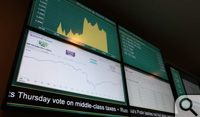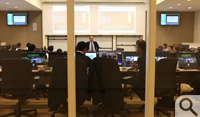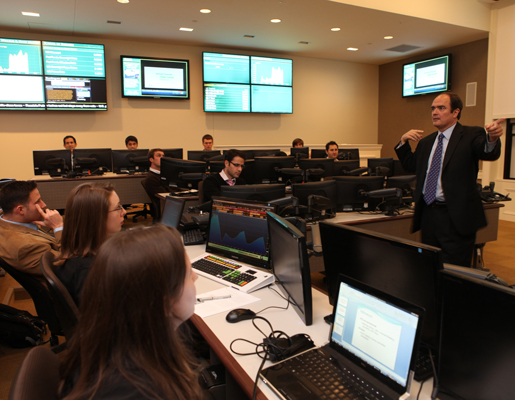Even the money is real
Wall Street intersects with Ukrop Way in the high-tech, high-stakes 'trading room.'
The trading floors of Wall Street are the farthest things from the ivory towers of academia. But the Mason School’s commitment to “bring business into the business school” drove the establishment of the Marshall Acuff Financial Markets Center, as well as the activities that go on inside it.
John Merrick is Richard S. Reynolds Associate Professor at William & Mary’s Mason School of Business. A veteran of Wall Street trading floors, Merrick designed a room in Alan B. Miller Hall to serve both as a premier high-tech classroom and a lab able to simulate the environment of the trading floor for his M.B.A. students in finance.
 The Acuff Financial Markets Center—the “trading room,” as it’s often called—features 11 wall-mounted large-screen monitors firehosing information. There are world news crawls, market snapshots, stock price graphs and constantly updating pages from selected financial web sites. Typically, three of the monitors are tuned to CNBC—subtitles/no sound.
The Acuff Financial Markets Center—the “trading room,” as it’s often called—features 11 wall-mounted large-screen monitors firehosing information. There are world news crawls, market snapshots, stock price graphs and constantly updating pages from selected financial web sites. Typically, three of the monitors are tuned to CNBC—subtitles/no sound.
It’s an appropriate and powerful setting for Merrick’s Career Acceleration Module (CAM) for second-year M.B.A. students. CAMs are seven-week immersive classes heavy on direct contact with the field’s top practitioners. Merrick notes that these CAM interactions not only develop his students, but also help to drive his academic research program.
For example, a visit from the Federal Home Loan Bank’s Office of Finance led the FHLB to provide proprietary data to Merrick and his teaching and research colleague Vladimir Atanasov to support analysis of its debt auctions. Atanasov is a visiting professor in economics and finance at the Mason School. This summer, the two will collaborate on an innovative study of securitized asset pricing using new data provided by the Financial Industry Regulatory Authority—again a by-product of CAM speaker connections.
The power of the CAM
Students have no other courses while they’re enrolled in a CAM and so Merrick and Atanasov are able to fill a bus with their financial markets students and head to New York to meet with hedge fund managers and other heavy hitters in the financial world. In Williamsburg, though, classes are taught in the trading room, which Merrick says complements the CAM principle. The silent yammering of the monitors is all part of the training for the real world of financial markets.
 “I want to teach in a room that’s full of technology. I want to teach in a room that’s full of random distractions,” Merrick said. “That’s what the trading floor environment is like. You have to be able to treat that as background and learn to operate in that sort of culture. To me, that’s one of the benefits of the room—providing distractions that you learn to work in comfortably.”
“I want to teach in a room that’s full of technology. I want to teach in a room that’s full of random distractions,” Merrick said. “That’s what the trading floor environment is like. You have to be able to treat that as background and learn to operate in that sort of culture. To me, that’s one of the benefits of the room—providing distractions that you learn to work in comfortably.”
Seating in the room is arranged in a multi-level horseshoe facing a pair of giant projection screens that display what’s going on in class. Each seat is outfitted with a pair of monitors and a keyboard. Scattered among the seats are white keyboards with additional brightly colored buttons marking the presence of the nine Bloomberg terminals.
The Bloomberg terminal is an indispensable tool for today’s security traders. It provides an immediate conduit to data and analysis on thousands of individual securities on the market, allowing a degree of due diligence that just wasn’t available a decade ago.
“There’s information at your fingertips of the structure of the security and also how Wall Street values it,” Merrick said. “If you’re a salesperson on Wall Street you would do your analysis on the Bloomberg machine, save the results, and ship them out immediately to your customer. We want to get to that stage where students are analyzing results and talking among themselves, just like professionals on Wall Street.”
CAM students use the Bloombergs in class and for the homework assigned to lab groups of four students. Merrick outlines a typical homework assignment: Use futures contracts to hedge an interest-rate swap.
“Each group is given an interest-rate swap position upon which they must make the floating side payments. The position is risky, since interest rates can go up or down. The groups are assigned to hedge that exposure using an interest rate futures market and constructing the correct futures contract trade,” he explained. “They’ll use the Bloomberg to help find out how many contracts to use, and they’ll try to assess what the risk reduction will be.”
Athletes to mathletes
Merrick notes that Bloomberg terminals and other technology have changed not only the way financial markets are conducted, but also the type of men and women involved.
“When I first started at Lehman Brothers in 1988, the trading floor was filled with ex-athletes,” he explained. “The idea was that athletes are competitive, coachable, and they know how to come back from a loss. If you were to walk out onto a Wall Street trading floor now, you would most likely find a mathlete, not an athlete.”
In the final days of the 2011 fall semester, Merrick and Atanasov have assembled the mathletes and athletes of the CAM to present and hear committee reports. It’s a bit of a historic moment, as the second-year M.B.A. students have been tasked with starting to assemble a framework for future financial markets CAMs.
The 2010 M.B.A. class gift seeded the Dittrick Fixed-Market Income Fund with investment capital for use by subsequent financial market CAMs. The fund honors the late John J. “Jack” Dittrick, Jr., an influential Mason School professor and assistant dean who passed away in 2009.
“This CAM will be investing with real money,” Merrick says. The seed amount is expected to grow through increased capital influx and—more to the point—through astute and successful investment by a student-led fund management. Running an investment fund with real money offers students the motivation that comes from playing for keeps.
“There’s a this-is-not-a-drill aspect to it,” Merrick said. “It gets the blood going.”
The flip side of the coin is the accountability that comes with the opportunity. “If you make a mistake, it can’t be erased,” Merrick said. “You can’t erase the file and say it didn’t happen. The students will have to live with it and be judged by it.”
The fall 2011 CAM was tasked with drawing up a framework and a set of operating principles for the managers of the new fund. It’s a challenging assignment, one that must take into account a number of sometimes conflicting factors.
“We have two mandates,” Merrick explained. “We want the fund to do well. But we also have an educational purpose. And that’s the challenge: How do you put together something that is true to our fiduciary responsibility to grow the endowment, and also something that’s true to education, the learning-by-doing approach?”
Reality checks
Reports by the CAM committees at the final class session showed the challenges of reconciling the fiduciary and educational goals of the fund, as well as other nuts-and-bolts aspects. What kind of oversight should there be on student fund managers? How can the fund stay active when school isn’t in session? What mix of investment-grade versus high yield securities would make for the optimum portfolio? What’s the best hold-sell strategy? Merrick punctuates the committee recommendations with reality checks.
“You guys come here with a timeline where we’re picking bonds in the first week of class,” he says. “We can’t even spell bonds in the first week of class!”
Merrick and Atanasov guide the discussion toward consensus. Atanasov writes the best ideas on a whiteboard for use by a panel with representation from all subcommittees. The panel reconciled all the best ideas of the subcommittees. Merrick noted that the job of designing the fund will be continued in the fall by the class of 2012.
“This ‘design the fund’ stage is at least as educational—if not more so—as actually running the fund will be for later classes,” Merrick said. ![]()
















